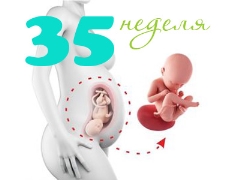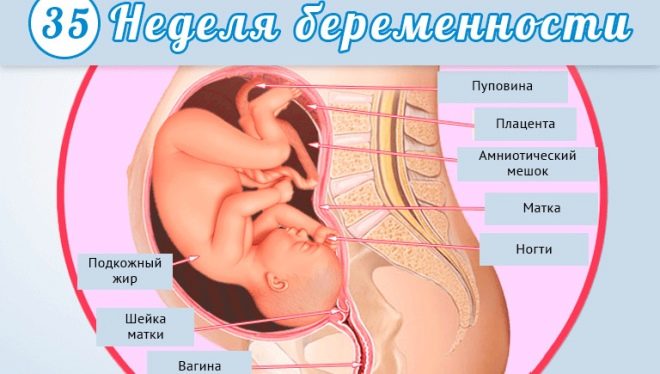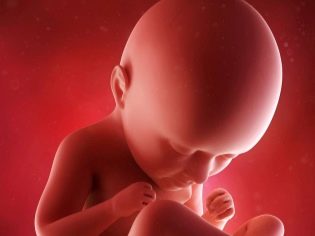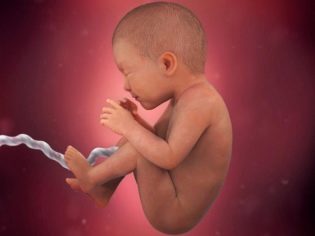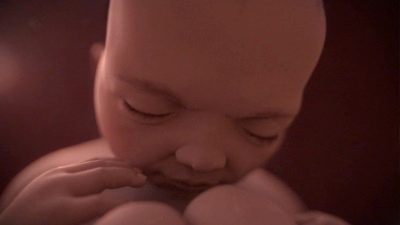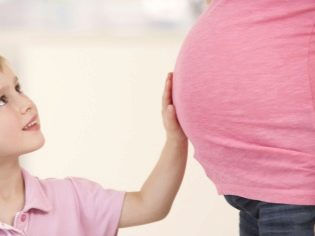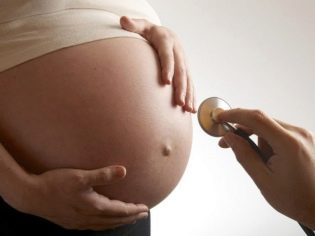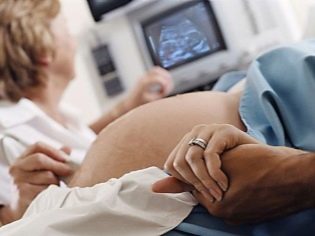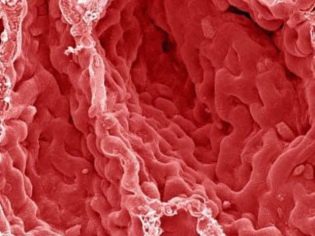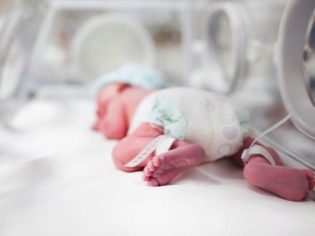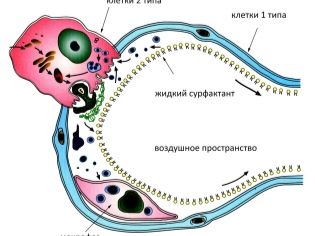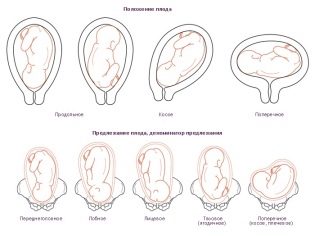Fetal development in the 35th week of pregnancy
The baby will be born in a few weeks. During this short period of time, the entire children's body should prepare for life outside of my mother's abdomen. This article will tell about the features of fetal development at week 35.
What does it look like?
A number of changes occur in the appearance of the child. He is becoming more like a baby, because very soon the crumb will be born. At 34-35 obstetric week, the baby has specific features that are unique to him.
All the main anatomical zones on the small face of the fetus are already quite well visualized. Thus, in the upper half of the child's face, the forehead is clearly visible. The nose of the fetus is not as flat as before. On the sides of the face are well-defined ears.
The cheeks of the fruit every day are becoming more plump. This specific roundness, characteristic of newborn babies, is attached to them by fat, which begins to be deposited under the skin.
Adipose tissue is also formed in other parts of the body. The main "fat depot" in the fetus are located in the abdomen, buttocks, limbs. At 35 weeks of gestation, the amount of adipose tissue in the children's body, according to scientists, is approximately 7%.
The importance of subcutaneous fat for a growing children's body can not be overestimated. Fat, which is under the skin, is a kind of fuel. When it is metabolized in the body produces a lot of energy that is spent on all basic needs. So, without a sufficient amount of adipose tissue, the baby after its birth can quickly freeze.
Basically, the baby has brown fat. It is he who accumulates under the skin, giving it a specific pink-reddish tint. However, white subcutaneous fatty tissue, although in a much smaller quantity, is also present. At the final stage of pregnancy it is very important that the baby gains more weight, and does not grow in length. The increase in fat in the children's body and the active development of muscles is necessary in order for the baby to continue to be ready to live in the external environment independently.
The accumulation of adipose tissue in the children's body leads to a change in the proportions of the body in a child. At the 35th week, mainly the formation of fatty layers occurs in the upper shoulder girdle. The accumulation of fatty tissue in the limbs makes the child’s arms and legs especially cute.
The skin of the fetus is wrinkled. This is because the baby is constantly in the amniotic fluid. Every day the color of the skin changes. So, at 35 weeks, the skin has a pretty pink color.
The amount of the original lubricant is gradually decreasing. Her clusters are mainly in places of natural folds on the skin of the child. Thus, the original lubricant is quite a lot in the neck, in the armpits, in the elbow and popliteal fossae, and in the folds on the abdomen.
Lanugo (special hair) in a baby gradually decreases. Fine fluff hair just fall off the surface of the body of the fetus. The growth of hair on the head at the same time increases.Eyelashes and eyebrows are also actively growing.
It is important to note that an individual pigment begins to appear in the hair causing hair coloring.
Movements
By this time, the fetal motor activity also changes. An already relatively large-sized baby becomes very crowded in the uterus.
The child will soon begin to sink into the pelvis. In the pelvis there will be significantly less space than in the abdominal cavity, which is why the baby tries to "group". He, as a rule, crosses his hands and legs, and lowers his head a little. At the same time, his chin gets closer to his chest.
A baby who weighs more than two kilograms, it is already difficult to actively move in the uterus, but he still makes active movements. Often they are manifested by the fact that the child "kicks" the walls of the uterus. Since the fetus is already quite large and large, a pregnant woman feels quite vividly about his movements. In some cases, the expectant mother may even feel that she is hurt if the child is strongly pushed.
Almost every pregnant woman watches how intensely and often her baby pushes. It is important to remember that while this should be monitored and other symptoms. If the future mother has severe abdominal pain or leakage of amniotic fluid, she should consult with her gynecologist.
In some cases, childbirth may begin somewhat earlier than the scheduled target date. In this situation, you should not hesitate to contact the doctors. This is especially important if the baby is in pelvic or breech presentation.
Anatomical features
By the 35th week the baby has grown quite strongly. With each successive day of pregnancy, the child will gain more weight than grow in length.
Measuring fetal body size is a very important indicator of intrauterine development. Conducting special ultrasound tests provides physicians with a lot of information about the size of the fetus. If in the preceding weeks they needed this information more in order to assess how the development and growth of the internal organs of the fetus is going, now it is needed mainly for drawing up the correct tactics of obstetric assistance.
After the survey, a conclusion is made, which reflects all the measured parameters of the baby’s body. The doctor evaluates this conclusion, who monitors the course of pregnancy.
To assess the size of the baby at each stage of pregnancy, doctors use special clinical signs. For this, the parameters of the most important anatomical parameters are determined. The norms applied for this term of pregnancy are presented in the table below.
Study criteria | Norm in the 35th week of pregnancy |
Growth | 45-47 cm |
Weight | 2400-2450 grams |
Biparietal size (BPR) | 80-95 mm |
Forearm Bone Length | 49-57 mm |
Bone length of shin | 54-63 mm |
Thigh length | 61-72 mm |
Shoulder length | 54-65 mm |
Abdominal circumference | 28.4-34.4 cm |
Head circumference | 29.8-34.5 cm |
Frontal-nuchal size | 102-122 mm |
How is it developing?
An important task of the upcoming final period of pregnancy is the preparation of the body of the fetus for a new "mode of operation", as well as the transition to a qualitatively new environment. For this it is very important that all the major organ systems of the baby are well formed and able to function. The final period of pregnancy (third trimester) is a very important period.
A child who is in the womb is able to experience his own feelings. This unique feature is due to the fact that the baby has quite well developed sense organs. These nerve analyzers are needed by the body in order to be ready to respond to environmental factors. Doctors call such a feature adaptation, that is, the ability to change the organism under the influence of the external environment.
In order for the baby to listen to the sounds around him, the child has the ability to hear.
A 35-week-old child already quite well distinguishes the voices of his parents, and his father’s voice usually gives him a little more pleasure, since it is lower in timbre. Scientists have found that at this stage of pregnancy the fetus perceives the sounds of this particular range better.
The ability to distinguish between light and darkness is another child’s skill. It is important to note that the child will fully respond to the light only after his birth, but for now he only has reflex responses that are protective. For example, when bright rays hit the face, the child instinctively closes the eyelids and even tries to turn away from them.
Interestingly, in this period the child is already able to dream. This opportunity contributes to the strong development of the brain. There are already a lot of furrows and convolutions. Every day the higher nervous activity of the fetus increases. This contributes to the fact that the child appears more and more reflexes. At this stage of pregnancy, the baby is already sleeping almost 18-20 hours a day.
The development in the fetus of special receptors on the tongue - taste buds - makes it possible to determine taste. Every day this ability continues to evolve. The baby determines the taste of amniotic fluid when swallowed. During this biological act of “nutrition”, specific training of the fetal respiratory muscles also takes place. In the future, strong pectoral muscles and diaphragm will allow the baby to take his first independent breath.
After the fetus has drunk amniotic fluid, it usually hiccups. This process is quite normal reaction of the baby. Moreover, fetal hiccup is necessary for the full development of its digestive system.
By the 35th week, the child's body is ready to move into a new habitat for it. The baby has already formed and even started to work the cardiovascular and nervous systems.
Born in the 35th week of pregnancy, the child is viable. The possibility of existence outside the womb is determined by the fact that the fetus already has its own heartbeat, and after the first breath, spontaneous breathing appears. However, not all babies born at this time may be ready for life. In this case, special care and a set of rehabilitation measures are required, which are carried out by neonatology doctors in specialized departments of hospitals.
The ability to self-breathing is due to a fairly good development of lung tissue. Man's own breathing is impossible without the presence in the lungs of a special substance - surfactant. Surfactant is necessary so that the alveoli - pulmonary vesicles - do not stick together when breathing. With each successive day of pregnancy, the amount of surfactant increases.
How is located in the womb?
The position of the fetus in the uterus is a very important clinical indicator. On how the fetus is located in the womb, the choice of obstetric tactics depends. The doctor chooses the method of obstetric assistance so that during birth the risk of dangerous birth injuries and injuries for both the mother and the fetus is minimal.
The position of the baby in the mother's womb, doctors call previa. There are different options for presentation. To determine it, doctors necessarily identify where the largest parts of the body of the fetus are.
The most favorable for birth is a longitudinal headache. In this case, the head end of the body of the child is first in the direction of the birth canal. In this case, during birth, the head will be born first.
As a rule, the rest of the body is "born" further easier, since they are smaller than the shoulders in size. Such a variant of presentation is called favorable because in this case natural birth is possible without significant birth injuries.
When pelvic presentation, when the pelvis of the fetus is directed first to the birth canal, the prognosis is less joyful. In such a situation, very often during childbirth, dangerous birth trauma occurs. To reduce their development, doctors often resort to performing cesarean section.
The transverse position, when the fetus is located across the longitudinal axis of the birth canal, is also less favorable. In this case, all large parts of the child are perpendicular to the birth canal. Independent childbirth with such a presentation is very dangerous.
By the 35th week, the position of the baby in the uterus, as a rule, is already permanent. The probability that the fruit will turn over again while there, but it is already quite insignificant.
If the baby is not in the head of presentation, then the expectant mother should be much more careful to monitor their feelings before childbirth.
For information on how the fetus develops in the 35th week of pregnancy, see the following video.
